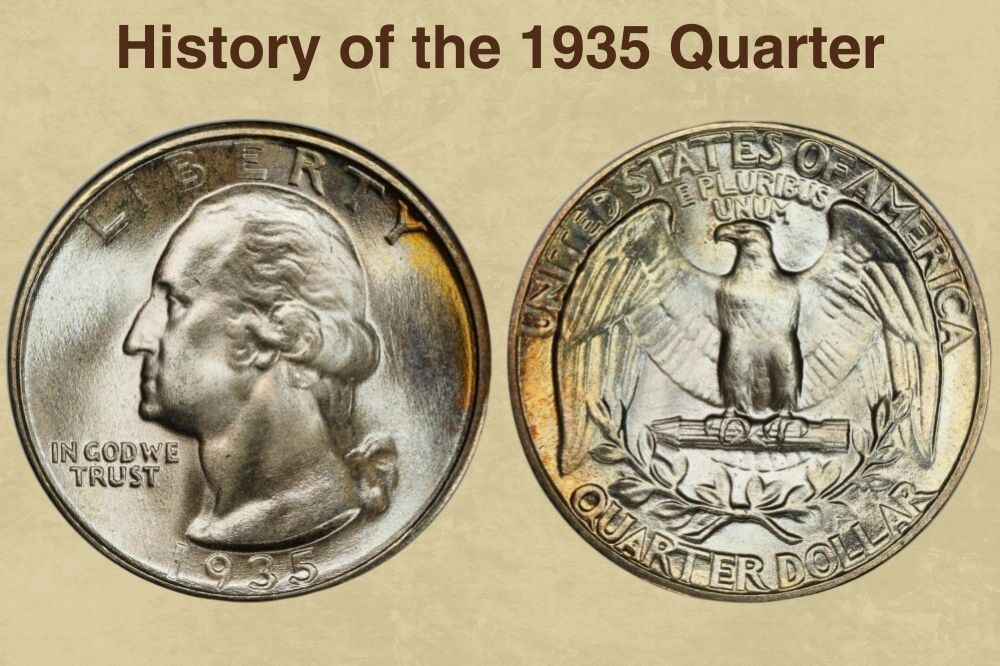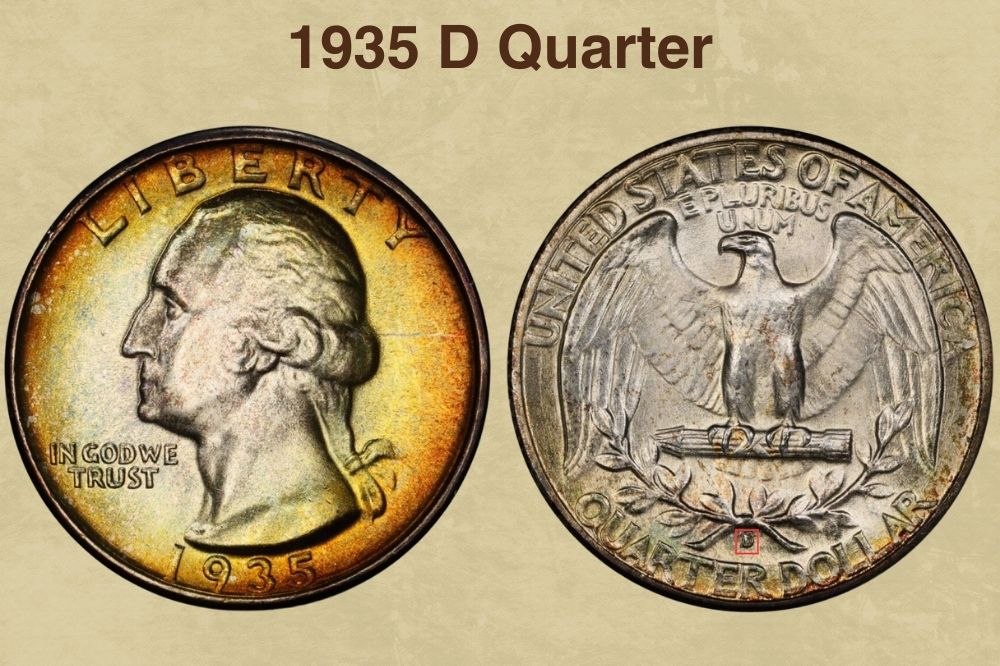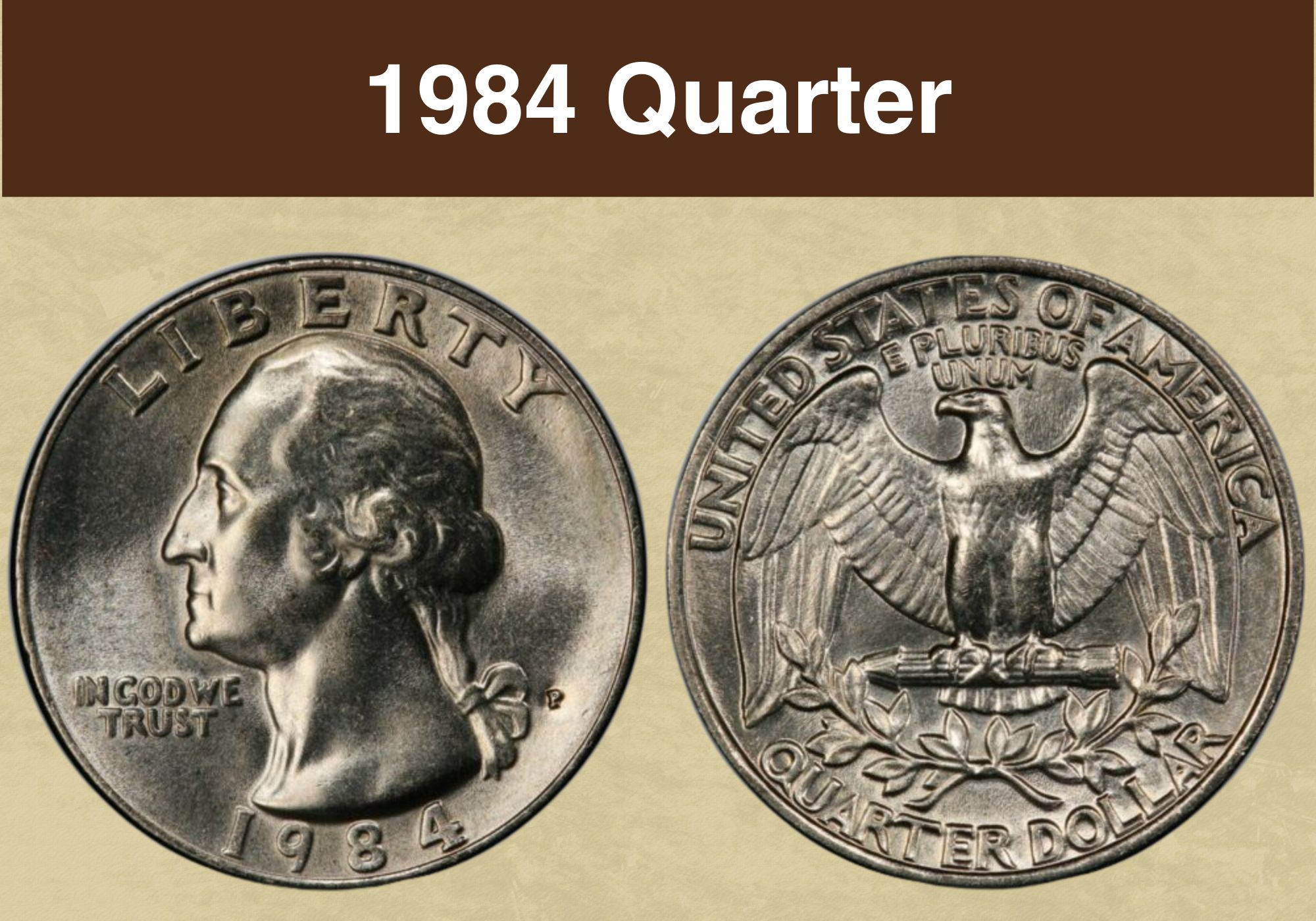
Coin Value Contents Table
In some ways, the Quarter or 25c coin was the truest representative of American democracy. It had our first president on one side and our national symbol on the other, quite a direct jab against the kings and queens of colonial coins. And today, it circulates more widely than any other coin, so it’s familiar among all demographics. Let’s zoom into the 1935 Quarter Value.
1935 Quarter Value Chart |
||||||
| Coin | AU 50 | MS 60 | MS 63+ | MS 65+ | MS 67+ | MS 68 |
| 1935 No Mint Mark Quarter | $9 | $29 | $57 | $115 | $1,350 | $7,000 |
| 1935-D Quarter | $95 | $225 | $300 | $475 | $4,250 | – |
| 1935-S Quarter | $30 | $80 | $130 | $275 | $2,500 | – |
History of the 1935 Quarter
Everyone knows that North America was originally populated by Native Americans. And while the first Western explorers came from Spain and later France, it was the British that made a foothold in what would later become the United States. When we officially formed a nation, we elected George Washington as our democratic leader. He was a Founding Father.
So it made sense that he would replace the British monarchs on US money. He didn’t like the idea though, and neither did Benjamin Franklin – another Founding Father. Instead, they both preferred a symbolic female figure that would represent our freedom. That’s how Miss Liberty ended up on early American coins. But the thing with democracy is the people rule.
This meant in 1932, the public finally got its way and placed George Washington on the 25c coin, commonly known as the Quarter. It was a celebration of his bicentennial – 200 years since he was born. The original idea was to have him on the Half Dollar, but a faction of Congress pushed for the Quarter instead. This worked out better since it circulates to date!
Why the Quarter Has Social Capital
In the end, the visibility of the Quarter made it the coin of choice for social messaging. Over the years, it’s been used to honor minorities, states, national monuments, regional parks, states, territories, and marginalized communities. And it has kept George Washington top of mind in the public, which was why we put him on the coin in the first place, so it’s a win-win!
Quarters were initially silver but that changed in 1965 when most US coins switched over to the cupronickel Johnson Sandwich. This move was necessitated by spikes in silver spot prices that led to massive coin hoarding. But in 1935, the Quarter was still 90% Silver with 10% Copper to harden the metal and make the coins easier to strike. It added longevity too.
While the portrait on the obverse (heads side) of the Washington Quarter rarely changed, the mint did a lot of experimentation on the font. In the early years, they played with the motto In God We Trust, testing it with a heavy, light, and medium font. The 1935 Quarter is notable because they only used the Medium Motto that year. By 1936, they had settled on the Heavy.
How to Identify Washington Quarters
From 1932 to 1998, all Washington Quarters had the same portrait on the front. But some were silver while others were clad cupronickel, meaning they had a copper core coated with 75% copper and 25% nickel. You can tell which coins are silver by checking the year since clad coins were introduced in 1965. But after 1992, some proof coins were 90% silver too!
If you check the thin side of the coin, you’ll see that some are evenly silver while others seem partially rusted. The ones with traces of red are clad coins because some of the nickel has worn off, exposing the copper core below. You can also check where the mint mark is. On the earlier Silver Quarters, the mint mark was on the back. But clad coins have it in on the front.
This differs on proof coins from 1992 and beyond, because some of them are silver but still have the front mint mark. Combine the mint mark position, the color of the coin edge, and the mint date to confirm what kind of quarter you have. You can also weigh the coins. Silver ones are 6.25g while clad ones are 5.67g. Be sure to get a good coin microscope for this task.
Also read: Top 13 Most Valuable State Quarters Worth Money
Features of the 1935 Quarter
We’ve already touched on some numismatic descriptors like the obverse of a coin. The back or tails side is the reverse while the thin side is the edge, and it has a raised border called a rim or collar. The edge might also have ridges called reeds. The words on a coin – as we said earlier – are mottos or legends. The images are devices and the coin background is the field.
The Obverse of the 1935 Quarter
It shows George Washington facing left. The motto In God We Trust is above his head while the legend Liberty is on the left, under his chin. The mint date runs along the bottom rim of the coin. His neckline cut-off is engraved JF to identify the coin designer as John Flanagan.
The Reverse of the 1935 Quarter
It shows an eagle holding arrows. Above its head is the motto E Pluribus Unum. An olive wreath goes from one wing tip to the other, with the mint mark below the central point of the wreath. The top of the coin says United States of America. The bottom says Quarter Dollar.
Other Features of the 1935 Quarter
Earlier, we confirmed that the 1935 Quarter was 90% Silver and 10% Copper. It weighed 6.25g, was 24.3mm in diameter, 1.75mm thick, and had 119 reeds on its edge. The reeds were a counterfeiting measure since you could tell if someone had scraped any silver off the edge.
1935 Quarter Grading Guides
Coins are generally graded on the Sheldon Scale which goes from 1 to 70. The most valuable coins are in the 65 to 70 range, and are defined as Mint State coins. Uncirculated coins are usually 50 to 58, though some people use Mint State and Uncirculated interchangeably. You can start by comparing your coins to online samples before you send them to an appraiser.
| # | Grade |
|---|---|
| 1 | Basal State-1 |
| 2 | Fair |
| 3 | Very Fair |
| 4, 5, 6 | Good |
| 7, 8, 10 | Very Good |
| 12, 15 | Fine |
| 20, 30 | Very Fine |
| 40 | Extremely Fine |
| 50 | About Uncirculated |
| 60 | Mint State |
| 65 | Mint State |
| 70 | Mint State |
Please check our grading guides to know your coin scale, It’s the necessary step to know the exact value of your coin.
Check out now: How to Grade Washington Quarter?
1935 Quarter Value Guides
In 1935, the US Mint only made business strike or regular strike quarters meant for everyday transactions. They didn’t make any proofs. The coins were minted in Philadelphia, Denver, and San Francisco, so let’s discuss the 1935 Quarter Values for each mint branch separately.
1935 No Mint Mark Quarter Value
In 1935, the Philadelphia Mint made 32,484,000 Quarters without mint marks. And the current price record for this coin wasn’t set that long ago. On 31st March 2021, an MS 68 sold for $7,200. It’s still the highest known grade, but PCGS has received 7 submissions so their value in October 2023 is $7,000. However, prices drop drastically just half a step downward.
PCGS has graded over forty coins as MS 67+ so their volume plummets their price to $1,350 in October 2023. The most recent sale was in February 2023, and that fetched $1,080. But resale rates also depend on the date of sale. The same grade of MS 67+ sold for $870 in May 2022 and $1,110 in November 2021. That said, finding coins in such high grades gets tricky.
You’re more likely to spot uncirculated coins from AU 50 to MS 60. But because so many of them exist, they’re not very valuable. In October 2023, an AU 50 is only $9 while an MS 60 is $29. About a hundred MS 62s have been sent to PCGS, so they go for $34 in 2023. However, MS 65 is a psychologically satisfying number so although over a thousand exist, they’re $100.
1935-D Quarter Value
The Denver Mint made 5,780,000 Quarters in 1935. They all had the D Mint Mark. Because their mintage volumes were lower, 1935-D coins cost more than their Philadelphia cousins. On 7th November 2003, an MS 67 sold for $9,775. But since then, PCGS has graded thirty coins as MS 67, so their value in October 2023 is $2,100. They’ve seen a few MS 67+s.
The eleven known coins in this grade are worth $4,250 in October 2023. In 2022, one sample sold for $3,240 in May and another for $3,120 in August. They were worth more in 2021 though, selling for $4,800 in March, $4,560 in June, and $4,080 in December. As more coins are submitted in this grade, the price continues to drop. Let’s look a bit lower.
PCGS has seen over thirty coins in MS 66+ so their value is $600 in October 2023. But in MS 66, close to three hundred coins have shown up so their value is $550. In the landmark grade of MS 65, over five hundred coins have been submitted to PCGS, so they go for $450 in October 2023. And with just over a hundred coins graded MS 62, those are worth $260.
1935-S Quarter Value
The San Francisco Mint coined 5,660,000 Quarters in 1935. They all had the S Mint Mark but they were not proof coins. On 26th July 2003, an MS 67 sold for $6,900. Almost eighty of these have shown up at PCGS so their value is $1,000 in October 2023. Half a step down, a little less than twenty coins have been graded as MS 67+ so their value in 2023 is $2,600.
If you look at MS 66+ c0ins though, the value is almost half MS 67 pricing at $450. That’s because PCGS has seen almost 350 coins in MS 66, which it estimates at $385 in October 2023. As a result, though MS 66+ are less than forty, their value is dragged down by their neighboring coin. Looking at MS 65, PCGS has seen more than 650 pieces so they’re $225.
And down to MS 62, the number of graded coins is approaching two hundred so each coin is worth $100 in October 2023. That said, all these coins will reach their 100th anniversary in 2035 so if you’re willing to hold on to them that long, you may get a better price. You could also target 2032, which will be 300 years since Washington’s birth. That’s a solid milestone.
Also read: Top 16 Most Valuable Modern Quarters Worth Money
Rare 1935 Quarter Errors List
Mint errors can make a coin more valuable. And mistakes that are spotted within 30 days of the coin’s original release are called first-strike errors. They get FS Numbers and cost more than mistakes discovered later. In 1935, the best-known error is the DDO designated FS-101. But other mistakes can still be profitable, so let’s review some common 1935 Quarter Errors.
1935 (P) Quarter DDO
DDO means doubled-die obverse, sometimes called hub doubling. It’s when the die moves between the first and second strike, forcing the second strike to land somewhere else and creating a sort of double-vision effect. This flaw is then copied to every coin struck by that die. An MS 64 only sold for $25 on eBay in 2019. But an MS 63 can sell for $200 in 2023.
1935 (P) Quarter Broadstruck Error
The purpose of a coin collar is to make it stackable, maintain its shape, and ensure consistent face value. The rim can be formed using a detachable three-piece mold (on older coins) or an upsetting machine (for modern coins). If this retaining collar is flattened or widened on any side, it’s called a broadstrike. In the low grade of VF 30, this damaged coin sold for $35.
1935 (P) Quarter Partial Collar Error
When the whole rim gets misshapen, that’s called a broadstrike, and we discussed an example above. But sometimes, only part of the rim gets deformed. Usually on older coins where one of the three detachable mould pieces came off too soon. This is called a partial collar error and it creates uneven surface thickness. Graded MS 60, this mint mistake was around $90.
1935 (P) Quarter Indented by a Dime Planchet
This is an interesting error because the back of the coin was obstructed by a dime blank. You can tell because the circular indentation is the size of a 10c coin. But you can still see traces of the eagle pushing through the blockage … or brockage. The dime may have gotten stuck on the die it may have been accidentally fed into the press. In AU 58, this error sold for $2,600.
Also read: 17 Most Valuable Quarter Errors Worth Money
Where to Sell Your 1935 Quarter ?
Now that you know the value of your coins, do you know where to sell those coins online easily? Don’t worry, I’ve compiled a list of these sites, including their introduction, pros, and cons.
Check out now: Best Places To Sell Coins Online (Pros & Cons)
1935 Quarter FAQ
What is a 1935 Quarter Worth?
So far, the highest known grade for 1935 Quarters is MS 67+. Among Philadelphia coins, less than ten MS 68 Quarters have shown up. In October 2023, a 1935 (P) Quarter graded MS 67+ is worth $1,350 while a 1935-D Quarter in MS 67+ goes for $4,250. Meanwhile, a 1935-S Quarter in MS 67+ is worth $2,600. But the 1935 (P) graded MS 68 can sell for over $7,000.
Are Quarters from 1935 Made of Silver?
Yes, 1935 Quarters are 90% Silver and 10% Copper. This composition continued until 1964. Also, after 1992, about a third of proof quarters were made from 90% Silver and 10% copper.













